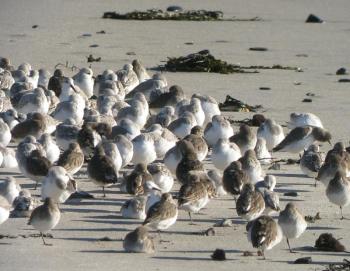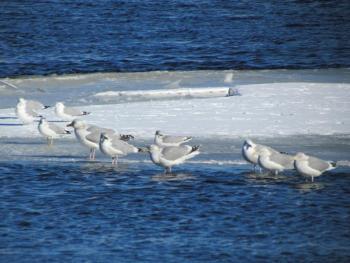A Flock or Not?
Last week we saw the sleek, black form of our first common grackle of the year sitting by itself in the top of the tall, leafless maple tree across the street from our home. Its harsh “check” calls are among the first signs of the spring return of migratory birds to the neighborhood. Only four days later, on our morning dog walk, we heard that “check” multiplied many times and looked up to see a hundred common grackles flying over in a tight flock. They never stopped, disappearing quickly over the treetops.
More evidence of the return to spring.
Then, just Sunday night as the last reddish light was fading in the western sky, we stopped briefly by a small overgrown field on our way out of town and rolled down the windows. The chilly early spring air smelled of mud and dried grass.
“Peent.”
There it was, the welcome buzzy sound of an American woodcock! It was by itself, just like that first grackle of the spring that we had seen earlier in the week. But a flock of an American woodcock was not something that we would expect to see later in the spring.
Why not?
Because American woodcock are never known to occur in what could be called a “flock.” Hunters sometimes talk of “flights” of woodcock, meaning that many migrating birds can be found moving through an area. The solitary movements of woodcock differentiate them from many of the closest relatives of the woodcock—birds in the shorebird family like sandpipers, yellowlegs, and curlews. These birds are commonly seen in close association with each other on feeding grounds, at roosting sites, and flying together in migratory movement.
Sandpipers regularly occur in flocks of hundreds or thousands. Western sandpipers have been counted in flocks occasionally that number in the hundreds of thousands.
The largest flocks we have seen were those of snow geese coming in to roost at the north end of Cayuga Lake in upstate New York. We estimated over a million birds! But should that aggregation of birds be considered a single flock?
We won’t pretend to answer that question except to say that there are many ways to define what is and isn’t a flock.
Many bird species form flocks only in certain seasons. The familiar American robin that spends the summer in the backyard will fight off an intruding bird tooth and nail at that time of the year. But in migration and winter, robins can be seen in flocks that occasionally number in the hundreds—with no sign of animosity toward their flockmates.
One hypothesized benefit of flocking is that it provides protection from predators. The idea is that the more birds that are together in the flock, the more eyes and ears available to detect a predator. Indeed, there have been a number of interesting studies to show that in many bird species, the larger the flock, the quicker they are to detect and take flight from potential approaching predators.
Of course, there are other potential benefits to belonging up, including perhaps the ability to increase detect food sources or to gain efficiencies by foraging for prey together. There may be downsides, too. Lots of birds together might mean that each individual bird has to fight harder to get and swallow its food before another individual steals it away.
Some birds of a feather flock together and some don’t. Whether it’s a spray of blackbirds zipping along over the treetops or a lone woodcock “peent”ing in an evening field, spring is coming and so are the birds!
Jeffrey V. Wells, Ph.D., is a Fellow of the Cornell Lab of Ornithology and Vice President of Boreal Conservation for National Audubon. Dr. Wells is one of the nation's leading bird experts and conservation biologists. He is a coauthor of the seminal “Birds of Maine” book and author of the “Birder’s Conservation Handbook.” His grandfather, the late John Chase, was a columnist for the Boothbay Register for many years. Allison Childs Wells, formerly of the Cornell Lab of Ornithology, is a senior director at the Natural Resources Council of Maine, a nonprofit membership organization working statewide to protect the nature of Maine. Both are widely published natural history writers and are the authors of the popular books, “Maine’s Favorite Birds” (Tilbury House) and “Birds of Aruba, Bonaire, and Curaçao: A Site and Field Guide,” (Cornell University Press).
































